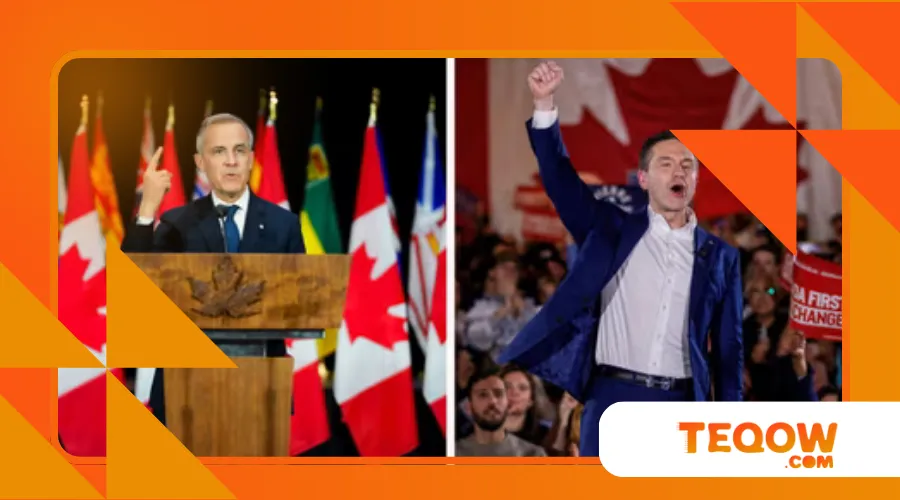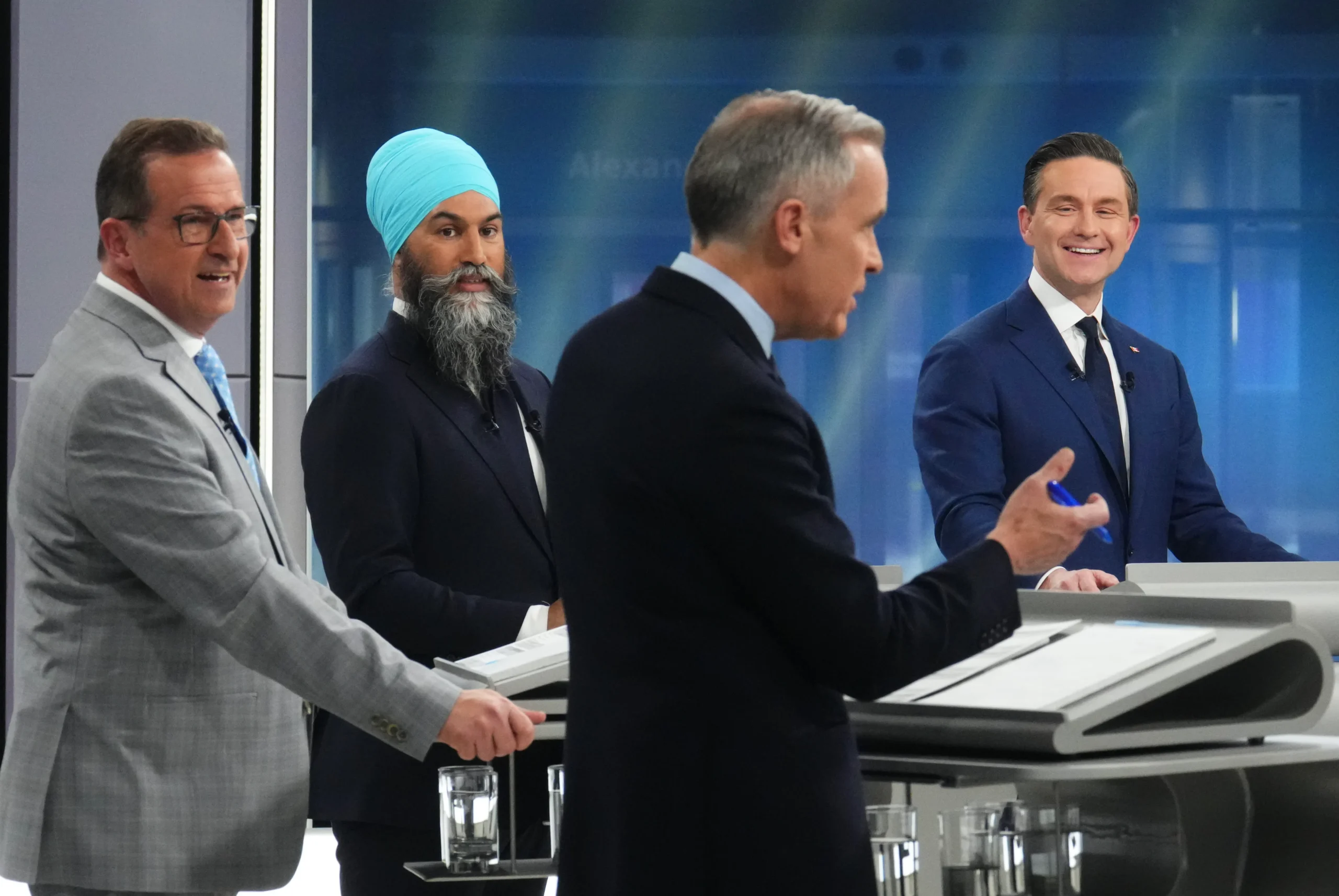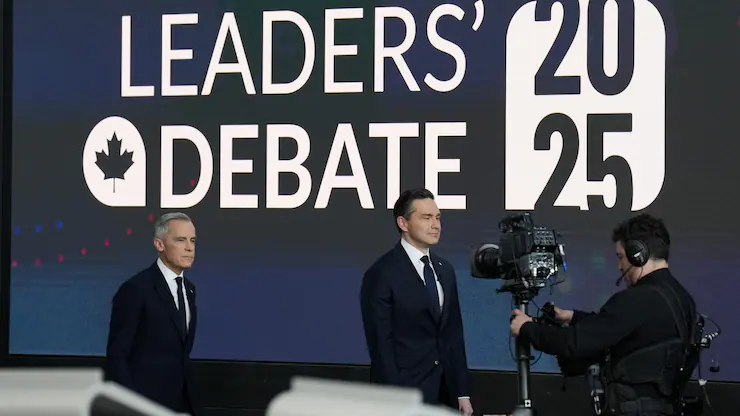Federal Election Enters Final Week with Carney Leading in the Polls

As the federal election enters final week, Canada stands at a crossroads, with Liberal leader Mark Carney holding a commanding lead in polls.
The April 28, 2025, vote is not just a contest for political power but a referendum on the nation’s resilience against external pressures, particularly U.S. President Donald Trump’s tariff threats.
Carney, a former central banker with a global reputation, has framed this election as a fight for Canada’s sovereignty and economic future.
With the Conservative Party, led by Pierre Poilievre, struggling to regain momentum, the campaign’s final days promise high stakes and fierce debates.
What will Canadians prioritize when they cast their ballots—stability or change?
A Campaign Redefined by Crisis
The narrative of this election has been anything but conventional.
When Justin Trudeau announced his resignation in January 2025, the Liberals appeared doomed, trailing the Conservatives by over 20 points in polls.
Poilievre’s populist rhetoric about a “broken Canada” resonated with voters grappling with housing affordability and inflation.
Yet, Trump’s aggressive trade policies—imposing 25% tariffs on Canadian steel, aluminum, and autos—shifted the political landscape.
Carney, sworn in as prime minister on March 14, seized the moment, positioning himself as the steady hand to navigate this crisis.
His call for a snap election on April 28 was a calculated gamble, leveraging a surge in Canadian nationalism to rally voters.
Carney’s messaging has been sharp and evocative.
At a rally in Kitchener, Ontario, he declared, “Trump wants to break us, but Canada will stand tall—like a hockey team facing a tough opponent, we’ll fight to win.”
This analogy resonates deeply in a nation where hockey is a cultural touchstone, framing the election as a collective defense against external aggression.
Polls reflect this shift: a Leger survey from April 14, 2025, shows 47% of Canadians prefer a Liberal win, with Carney’s experience at the Bank of Canada and Bank of England cited as a key factor in his appeal.
Moreover, Carney’s ability to connect with everyday Canadians through relatable metaphors has helped solidify his support.
His emphasis on unity and resilience resonates particularly well with those feeling the pressures of external economic threats.
As the election draws closer, the urgency of his message becomes more pronounced, pushing voters to consider the implications of their choices.
The Tariff Threat: A Unifying Force
Trump’s tariffs, coupled with his provocative claim that Canada could become the “51st U.S. state,” have galvanized voters in unexpected ways.
From Vancouver’s tech hubs to Halifax’s fishing communities, Canadians are rallying around a shared identity.
Carney has capitalized on this, promising retaliatory tariffs with “maximum impact in America, minimum pain in Canada.”
His plan to diversify trade partners—strengthening ties with Europe and Asia—offers a proactive vision, contrasting with Poilievre’s focus on domestic tax cuts and deregulation.
Consider the case of a Windsor, Ontario, autoworker named Sarah, who voted Conservative in the last election.
Facing job insecurity due to Stellantis pausing production amid U.S. tariffs, she now leans Liberal, drawn to Carney’s promise of a tariff relief package for workers.
“I don’t trust Poilievre to stand up to Trump,” she says.
“Carney talks like he’s already got a plan.”
This sentiment echoes across battleground ridings, where economic anxiety overshadows traditional partisan divides.
The unifying effect of the tariff threat is evident, as voters recognize the need for a strong leader who can protect Canadian interests.
Carney’s approach emphasizes not just retaliation but also collaboration with other nations to create a more balanced trade environment.
This strategy appeals to a broad spectrum of voters, from industrial workers to small business owners, who see the potential for a more secure economic future.
| Issue | Carney’s Position | Poilievre’s Position |
|---|---|---|
| U.S. Tariffs | Retaliatory tariffs, diversify trade partners | Support tariffs, focus on tax cuts |
| Economic Strategy | Middle-class tax cuts, infrastructure investment | Lower taxes, deregulate resource projects |
| Sovereignty | “Canada strong, Canada free” | “Canada First,” military base in Iqaluit |
Poilievre’s Struggle to Pivot
Poilievre, once poised for a landslide, has struggled to adapt.
His “Canada First” slogan, while patriotic, lacks the specificity of Carney’s trade diversification plan.
At a Toronto rally, he accused Carney of perpetuating a “lost Liberal decade,” but the attack feels dated without Trudeau as a foil.
Poilievre’s attempt to distance himself from Trump—declaring “I’m not MAGA”—hasn’t fully dispelled perceptions of ideological overlap, especially after Alberta Premier Danielle Smith’s controversial Breitbart interview suggested tariffs were hurting Conservative polling.
In a hypothetical scenario, imagine a small business owner in Calgary named Raj, who exports lumber to the U.S.
Facing Trump’s threatened lumber tariffs, Raj wants clarity on how candidates will protect his livelihood.
Carney’s pledge to negotiate exemptions under the Canada-United States-Mexico Agreement (CUSMA) feels tangible, while Poilievre’s promise to “axe taxes” seems vague in the face of global trade disruptions.
Raj’s dilemma mirrors the broader electorate’s demand for pragmatic solutions over populist rhetoric.
As voters seek leaders who can provide concrete answers, Poilievre’s vague promises may leave them feeling uncertain about his capabilities.
Moreover, the contrast between Carney’s detailed policy proposals and Poilievre’s generalizations highlights the importance of specificity in political messaging.
This disconnect could alienate undecided voters looking for a clear vision for Canada’s future in a turbulent global landscape.

+ Mark Carney Under Fire: Navigating Absence and Ambition in Canada’s 2025 Election
The Polls: A Liberal Surge
The numbers tell a compelling story.
As the federal election enters final week, the CBC News Poll Tracker shows the Liberals at 37.5% support, edging out the Conservatives at 37.1%.
This near-tie masks Carney’s advantage in key regions like Ontario, where 338Canada projects the Liberals could win up to 93 of 122 seats.
The shift is stark: in December 2024, Conservatives held a historic lead, but Trump’s actions and Carney’s ascendance erased it.
Why have Canadians pivoted so decisively?
It’s not just fear of tariffs—it’s trust in Carney’s economic credentials.
Moreover, Carney’s ability to communicate a clear and coherent vision for Canada’s future plays a significant role in his rising popularity.
Voters are increasingly drawn to his experience and expertise in navigating complex economic issues, particularly in the context of global uncertainty.
As the election approaches, the importance of voter engagement becomes paramount, with both parties scrambling to connect with undecided voters.
| Poll Source | Date | Liberal Support | Conservative Support | NDP Support |
|---|---|---|---|---|
| CBC News | April 21, 2025 | 37.5% | 37.1% | 11.6% |
| Leger | April 14, 2025 | 44% | 37% | Not reported |
++ How Provincial Governments Are Addressing Affordable Housing Shortages in 2025 alla romana
Beyond Tariffs: Domestic Priorities
While Trump dominates headlines, domestic issues like housing affordability remain critical.
The Ontario Home Builders’ Association warns that tariffs on steel and aluminum will inflate construction costs, exacerbating the housing crisis.
Carney’s pledge to build 500,000 affordable homes annually—evoking post-World War II rebuilding efforts—strikes a chord with younger voters.
Poilievre, meanwhile, focuses on streamlining regulations to boost housing supply, but his plan lacks the bold scope of Carney’s vision.
Carney’s broader platform, including a 1% income tax cut for the lowest bracket, appeals to dual-income families feeling the pinch of inflation.
His ability to weave domestic and international priorities into a cohesive narrative—strength at home to counter threats abroad—sets him apart.
Poilievre’s campaign, by contrast, feels fragmented, oscillating between anti-Liberal attacks and promises of economic nationalism.
This lack of cohesion may further alienate voters seeking a clear direction for Canada’s future.
Additionally, Carney’s focus on housing and economic stability resonates with a diverse electorate, from young professionals to families struggling to make ends meet.
By addressing these pressing issues, Carney positions himself as a candidate who understands the everyday challenges Canadians face.

The X Factor: Voter Sentiment on Social Media
On platforms like X, sentiment reflects the campaign’s intensity.
Posts highlight Carney’s lead, with users praising his “calm competence” while questioning Poilievre’s ability to pivot.
One user wrote, “Carney’s not perfect, but he’s the guy you want in a trade war.”
Another noted, “Poilievre’s stuck in 2024, yelling about Trudeau while Trump’s the real issue.”
These voices, while not definitive, underscore Carney’s edge in shaping the narrative as the federal election enters final week.
Social media serves as a barometer for public opinion, revealing the nuances of voter sentiment and engagement.
As Canadians turn to digital platforms for information, the influence of online discourse on voter behavior cannot be underestimated.
Candidates must navigate this landscape carefully, leveraging social media to amplify their messages while countering misinformation.
A Question of Leadership
As advance polls open, the federal election enters final week with a singular question: Who can steer Canada through this storm?
Carney’s global experience and measured tone contrast with Poilievre’s fiery populism, creating a stark choice.
The Liberals’ surge suggests voters favor stability, but Poilievre’s base—motivated by hope for a “better future,” per Leger’s April 14 poll—remains loyal.
The outcome hinges on undecided voters in swing ridings, where turnout could tip the scales.
Carney’s campaign has masterfully tapped into a rally-around-the-flag moment, but risks over-relying on anti-Trump sentiment.
Poilievre, meanwhile, must overcome perceptions of being out of step with the crisis.
The federal election enters final week with Canada’s identity on the line—not just as a sovereign nation, but as a people united against adversity.
Will voters choose the seasoned economist or the populist outsider?
The answer will shape Canada’s path for years to come.
For more news on the subject, see this CNN report.
Conclusion: A Nation at Stake
As the federal election enters final week, Carney’s lead reflects a nation seeking strength in uncertainty.
His vision—rooted in economic diversification, retaliatory tariffs, and domestic investment—offers a roadmap through the trade war.
Poilievre’s campaign, while resonant with some, struggles to match this clarity.
The federal election enters final week with Canada poised to decide its future: a united front against external threats or a gamble on untested change.
On April 28, voters will write the next chapter, and the world will be watching.
As the stakes rise, the importance of informed voting becomes paramount, with citizens encouraged to engage in the democratic process.
Ultimately, the outcome of this election will not only impact Canada’s immediate future but also set the tone for its role on the global stage.
In these final days, every vote counts, and the decisions made will resonate for generations to come.
